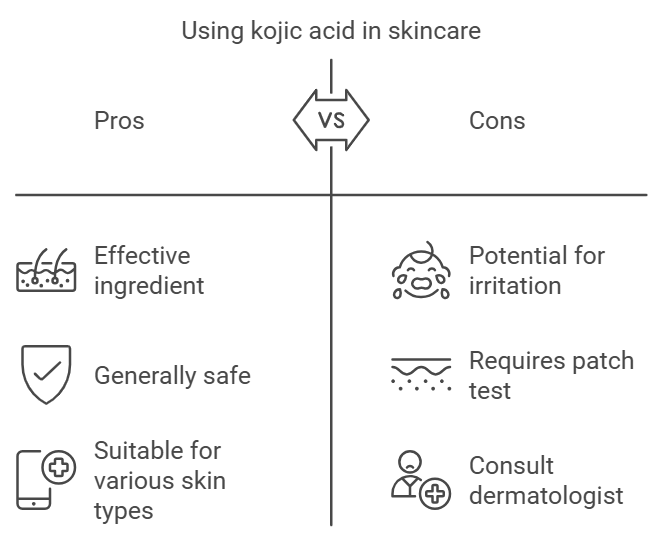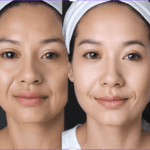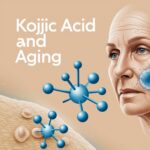- Kojic acid inhibits melanin production, leading to lighter, more even skin.
- Individuals with sensitive skin should start slow and patch-test before use.
- Some users may experience redness, irritation, or increased photosensitivity.
- Experts advise using kojic acid for no more than three months at a time
Derived from fungi, kojic acid is a natural compound known for its skin-lightening abilities. But the big question is—can everyone safely use kojic acid, or do some skin types need to approach it cautiously? Let’s break down the science behind how kojic acid works and who can benefit from its glow-boosting powers.

Benefits of Kojic Acid for Skin Lightening
Kojic acid has grown in popularity for its skin-brightening effects. Many people use it to reduce hyperpigmentation, melasma, age spots, and scars. Here’s why it’s become such a go-to ingredient for these skin concerns:
-
Targets Hyperpigmentation: Kojic acid is most well-known for fading dark spots caused by acne scars, sun damage, or aging.
-
Improves Skin Tone: Regular use of kojic acid can help achieve a more uniform skin tone, giving you that coveted, luminous glow.
-
Fights Signs of Aging: Because kojic acid fades age spots, it’s often included in anti-aging products.
Despite these impressive benefits, understanding whether kojic acid is safe for everyone is critical.
Safety of Kojic Acid Across Different Skin Types
Now, let’s dive into the safety profile of kojic acid. This ingredient is considered safe for most people, especially in concentrations of up to 1%. At these concentrations, kojic acid delivers effective skin-lightening results with minimal side effects. but like with any active skincare ingredient, some individuals may experience irritation or sensitivity.
Sensitive Skin: Should You Be Cautious?
If you have sensitive skin, you’ll want to take a more cautious approach. Kojic acid can be a bit too intense for skin that’s prone to redness or irritation. Dermatologists emphasize that people with conditions like eczema or rosacea should patch-test before full application.
While kojic acid is tolerated by most, those with sensitive skin should test it first to avoid irritation. This means starting slow and monitoring your skin’s response carefully.
Common Side Effects of Kojic Acid
Even though kojic acid is generally safe, it’s not without its potential side effects. Here’s what to keep an eye out for:
-
Redness and Irritation: Some users, particularly those with sensitive skin, might experience redness or irritation after using kojic acid.
-
*Contact Dematitis: In rare cases, kojic acid can cause allergic reactions, leading to contact dermatitis. Symptoms might include itching, swelling, or a rash.
-
Increased Photosensitivity: Since kojic acid makes the skin more sensitive to UV rays, sunscreen is a must.
Can Kojic Acid Cause Side Effects? How to Use It Safely
How Dermatologists React to Kojic Acid
Dermatologists have mixed views on kojic acid, especially regarding long-term use. Some see it as an effective tool for hyperpigmentation but recommend limiting use to avoid rebound hyperpigmentation. While less aggressive than hydroquinone, kojic acid still demands careful monitoring. It’s milder but requires the same vigilance to avoid irritation or overuse.
Everything you Should Know About Kojic Acid in Skincare
How to Use Kojic Acid Safely
Using kojic acid effectively requires a careful approach, especially if you have sensitive skin or are new to the ingredient. Here are some tips for getting the best results without side effects:
1. Start with Low Concentrations
Kojic acid is most effective and safe in concentrations up to 1%. Look for products that contain this concentration if you’re new to kojic acid. Using too high of a concentration can increase the risk of irritation, especially for sensitive skin types.
2. Patch Test First
Before applying kojic acid to your face or body, do a patch test on a small area of skin. This helps you gauge your skin’s reaction without risking widespread irritation.
3. Don’t Skip the Sunscreen
Because kojic acid increases photosensitivity, sunscreen is non-negotiable. Use a broad-spectrum SPF 30 or higher daily, even on cloudy days, to protect your skin.
4. Use It in Moderation
For best results, use kojic acid no more than once a day. And remember, it’s important to take breaks. Dermatologists often recommend cycling off after three months to prevent skin sensitivity.
5. Pair It with Soothing Ingredients
If you’re prone to irritation, combine kojic acid with calming ingredients like aloe vera, hyaluronic acid, or ceramides. These ingredients help counteract any dryness or redness that may occur.
Real-World Discussions on Kojic Acid Use
Many users in online forums report great success using kojic acid to fade stubborn dark spots and improve their skin’s overall clarity. Some, however, discuss initial irritation before adjusting their skincare routines to include more hydrating and soothing products.
In a popular Reddit thread, one user noted that integrating kojic acid into their routine alongside a heavy-duty moisturizer helped them overcome dryness. This is a common strategy, as hydration can buffer e ingredient’s harsher effects, making it more tolerable for sensitive skin types.
Conclusion: Is Kojic Acid Right for Your Skin?
Kojic acid is a powerful ally for those looking to tackle hyperpigmentation and uneven skin tone. While it’s generally safe for all skin types, caution is key, especially for those with sensitive or reactive skin. Always start with a patch test, use sunscreen, and take breaks after prolonged use. With the right approach, kojic acid can help you achieve a more luminous complexion, free from the dark spots and discoloration that often stand in the way of radiant skin.

I’m a devoted organic skincare enthusiast, passionate about the natural, wholesome goodness that organic products bring to our skin.
Organic skincare isn’t just a hobby for me—it’s a lifestyle. Every product I use, recommend, and write about has been carefully chosen for its purity and effectiveness. Everything I write about is backed by scientific studies, dermatologists’ opinions, and user experiences.
I also excel at tackling skincare challenges with innovative, organic solutions.

